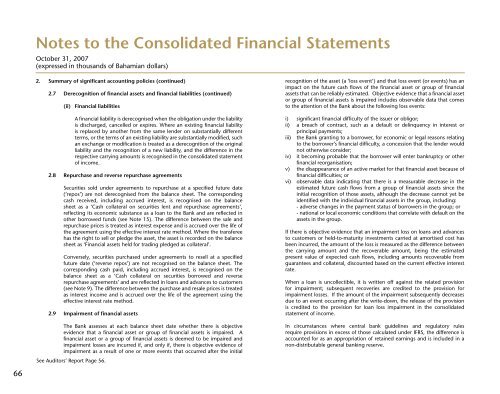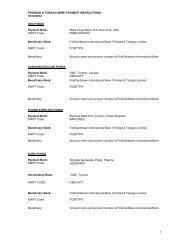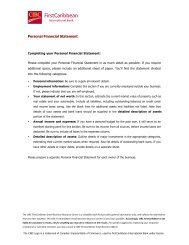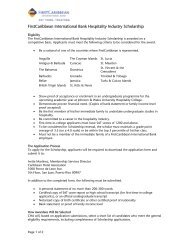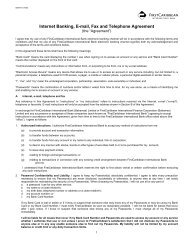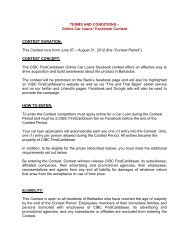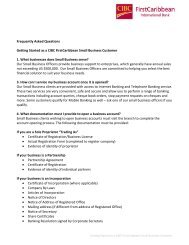Bahamas - FirstCaribbean International Bank
Bahamas - FirstCaribbean International Bank
Bahamas - FirstCaribbean International Bank
You also want an ePaper? Increase the reach of your titles
YUMPU automatically turns print PDFs into web optimized ePapers that Google loves.
Notes to the Consolidated Financial Statements<br />
October 31, 2007<br />
(expressed in thousands of Bahamian dollars)<br />
66<br />
2. Summary of significant accounting policies (continued)<br />
2.7 Derecognition of financial assets and financial liabilities (continued)<br />
(ii) Financial liabilities<br />
A financial liability is derecognised when the obligation under the liability<br />
is discharged, cancelled or expires. Where an existing financial liability<br />
is replaced by another from the same lender on substantially different<br />
terms, or the terms of an existing liability are substantially modified, such<br />
an exchange or modification is treated as a derecognition of the original<br />
liability and the recognition of a new liability, and the difference in the<br />
respective carrying amounts is recognised in the consolidated statement<br />
of income.<br />
2.8 Repurchase and reverse repurchase agreements<br />
Securities sold under agreements to repurchase at a specified future date<br />
(‘repos’) are not derecognised from the balance sheet. The corresponding<br />
cash received, including accrued interest, is recognised on the balance<br />
sheet as a ‘Cash collateral on securities lent and repurchase agreements’,<br />
reflecting its economic substance as a loan to the <strong>Bank</strong> and are reflected in<br />
other borrowed funds (see Note 15). The difference between the sale and<br />
repurchase prices is treated as interest expense and is accrued over the life of<br />
the agreement using the effective interest rate method. Where the transferee<br />
has the right to sell or pledge the asset, the asset is recorded on the balance<br />
sheet as ‘Financial assets held for trading pledged as collateral’.<br />
Conversely, securities purchased under agreements to resell at a specified<br />
future date (‘reverse repos’) are not recognised on the balance sheet. The<br />
corresponding cash paid, including accrued interest, is recognised on the<br />
balance sheet as a ‘Cash collateral on securities borrowed and reverse<br />
repurchase agreements’ and are reflected in loans and advances to customers<br />
(see Note 9). The difference between the purchase and resale prices is treated<br />
as interest income and is accrued over the life of the agreement using the<br />
effective interest rate method.<br />
2.9 Impairment of financial assets<br />
The <strong>Bank</strong> assesses at each balance sheet date whether there is objective<br />
evidence that a financial asset or group of financial assets is impaired. A<br />
financial asset or a group of financial assets is deemed to be impaired and<br />
impairment losses are incurred if, and only if, there is objective evidence of<br />
impairment as a result of one or more events that occurred after the initial<br />
See Auditors’ Report Page 56.<br />
recognition of the asset (a ‘loss event’) and that loss event (or events) has an<br />
impact on the future cash flows of the financial asset or group of financial<br />
assets that can be reliably estimated. Objective evidence that a financial asset<br />
or group of financial assets is impaired includes observable data that comes<br />
to the attention of the <strong>Bank</strong> about the following loss events:<br />
i) significant financial difficulty of the issuer or obligor;<br />
ii) a breach of contract, such as a default or delinquency in interest or<br />
principal payments;<br />
iii) the <strong>Bank</strong> granting to a borrower, for economic or legal reasons relating<br />
to the borrower’s financial difficulty, a concession that the lender would<br />
not otherwise consider;<br />
iv) it becoming probable that the borrower will enter bankruptcy or other<br />
financial reorganisation;<br />
v) the disappearance of an active market for that financial asset because of<br />
financial difficulties; or<br />
vi) observable data indicating that there is a measurable decrease in the<br />
estimated future cash flows from a group of financial assets since the<br />
initial recognition of those assets, although the decrease cannot yet be<br />
identified with the individual financial assets in the group, including:<br />
- adverse changes in the payment status of borrowers in the group; or<br />
- national or local economic conditions that correlate with default on the<br />
assets in the group.<br />
If there is objective evidence that an impairment loss on loans and advances<br />
to customers or held-to-maturity investments carried at amortised cost has<br />
been incurred, the amount of the loss is measured as the difference between<br />
the carrying amount and the recoverable amount, being the estimated<br />
present value of expected cash flows, including amounts recoverable from<br />
guarantees and collateral, discounted based on the current effective interest<br />
rate.<br />
When a loan is uncollectible, it is written off against the related provision<br />
for impairment; subsequent recoveries are credited to the provision for<br />
impairment losses. If the amount of the impairment subsequently decreases<br />
due to an event occurring after the write-down, the release of the provision<br />
is credited to the provision for loan loss impairment in the consolidated<br />
statement of income.<br />
In circumstances where central bank guidelines and regulatory rules<br />
require provisions in excess of those calculated under IFRS, the difference is<br />
accounted for as an appropriation of retained earnings and is included in a<br />
non-distributable general banking reserve.


